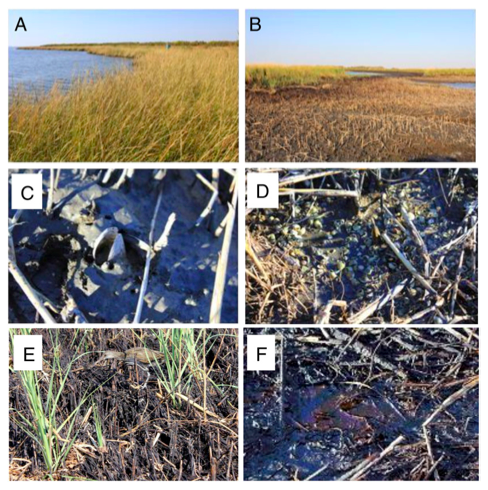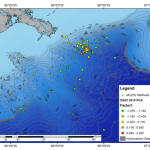Another oil spill study hot off the presses! This new Silliman et al. PNAS paper is looking at the effects of the 2010 Deepwater Horizon oil spill on heavily-impacted salt marsh ecosystems around Barataria Bay, Louisiana. In contrast to our own badass study looking at oil impacts on sandy Gulf Coast beaches, marshlands provide a particularly interesting contrast because:
Past studies investigating effects of oil spills on salt marshes indicate that negative impacts on plants can be overcome by vegetation regrowth into disturbed areas once the oil has been degraded (8, 28–30). This finding suggests that marshes are intrinsically resilient to (i.e., able to recover from) oil-induced perturbation, especially in warmer climates such as the Gulf of Mexico, where oil degradation and plant growth rates may be high. (Silliman et al. 2012)

The finding’s aren’t surprising. Oil killed stuff. But even after 2 years, there’s been more speculation than published research and I think its important to highlight ongoing efforts to characterize the exact ways in which oil wreaked havoc on the Gulf ecosystem.
These data provide evidence of salt-marsh community die-off in the near-shore portion of the Louisiana shoreline after the BP-DWH oil spill because of high concentrations of oil at the edge of the marsh. Specifically, these findings suggest that the veg- etation at the marsh edge, by reaching above the highest high- tide line in the microtidal environment of the Gulf of Mexico, blocked and confined incoming oil to the shoreline region of the marsh. This shoreline containment of the oil may have protected inland marsh but led to extensive mortality of marsh plants lo- cated from the marsh edge to 5–10 m inland and to sublethal plant impacts on plants 10–20 m from the shoreline, where plant oiling was less severe….These data also suggest that the mechanism of the lethal effects of oil are more likely derived from interference with respiration and photosynthesis than from direct toxicity because plant death only occurred at high levels of oil coverage. (Silliman et al. 2012)

Silliman et al. found that this oil-induced plan death effectively speed up the rate of erosion in Louisiana marsh ecosystems. Oiled sites eroded twice as fast as reference (non-oiled) sites, for a full year (October 2010-October 2011) before leveling back off again.
Our results suggest that there are reasons for both optimism and concern about the impact of this oil spill on Mississippi deltaic marshes of Louisiana. On one hand, our results reveal that marsh vegetation displays remarkable resilience to oil spills by concentrating and confining the effects of oil to the marsh edge, recovering fully in noneroded areas after ∼1.5 y, and suppressing, through this recolonization, further accelerated erosion rates along the shoreline. The lack of oil on the marsh surface or on grasses at distances greater than 15 m from the shoreline at any site (Fig. 1A) suggests that incoming oil sheens were contained and prevented from moving into interior marshes by a baffling wall of live and dying salt-marsh grasses, a process that in itself increases the resistance of the extensive marsh ecosystem to oil spill. However, this resistance comes at a high cost for the impacted areas because marsh grass die-off and subsequent sediment exposure to waves resulted in a more than doubling of the rate of erosion of the intertidal platform, leading to permanent marsh ecosystem loss. (Silliman et al. 2012)
Louisiana’s salt marshes play a critical ecological roles, acting as storm buffers and breeding grounds that underpin the entire Gulf seafood industry. But they have been in trouble for a looooong time. The BP oil spill added extra stress to these already-stressed ecosystems–yet another anthropogenic impact promoting further ecosystem decline.
Reference
Silliman BR, van de Koppel J, McCoy MW, Diller J, Kasozi GN, Earl K, et al. Degradation and resilience in Louisiana salt marshes after the BP-Deepwater Horizon oil spill. Proc Natl Acad Sci USA. 2012 Jun. 25.






i get it…but the more important story is the resilience of the ecosystem, right? if you think the only oil that has hit those species are ones that are anthropogenic, you’re mistaken…
and what of the microbes that did the bulk of the cleanup at the thermocline in the gulf? they have been around for untold thousands of years…why? because plate techtonics creates fissures and allows for the oil deposits to leak into the ocean…on a daily basis…all over the globe
just google ‘role of microbes degrading the BP oil spill’ and you can spend untold hours learning about these special ‘bugs’…that many have refused to appreciate
does this mean we can pollute willy-nilly? not a chance…but what this does mean is we have yet to even begin to grasp the web of life, and need to couch our statements of doom and gloom while being more proactive (like NOT rebuild a city that is below sea level using billions of dollars).
thanks for your article!
Well, typing above sea level in the city you are referring to, Robert, I think there may be some things out of your grasp yet.
Speaking to these marshes, how “resilient” the marshes are isn’t news. This study confirms what has been known for a while, that the microbes in salt marsh soils will, in a matter of years, process the hydrocarbons. I had a seminar on a number of studies at similar scales as this PNAS one when I was in grad seminars at UNO in 2007.
The mechanism of death (smothering) is behind the rationale for the use of dispersants–in mesocosm studies (I’m thinking of one by Mendelssohn at LSU) stem counts in ye olde 5-gallon buckets–dispersed oil killed much less Spartina than oil alone. But we shouldn’t make landscape-scale conclusions and decisions from mesocosm studies! And this disaster was beyond landscape-scale.
The resilience of the marshes is a fact has been quoted, again and again, to justify the underregulation of the U.S. oil industry in our area. So although you say “not a chance”; I would have to disagree.
I promise you this study will be cited as evidence that polluting willy-nilly is ok. I promise you that american scientists will forget about our marshes because of this result. Because the other plant-indicator-of-oil damage-to-marshes-in-the-field are cited and were forgotten. I don’t think i see any of those papers cited in the PNAS paper–I will have to dig them out.
The fact is that the marshes are not resilient at the landscape scale. Although this is not captured by the study, the conclusions do mention that TS Lee passed through the area while the marshes were impacted–so although the marshes do ‘bounce back,’ that takes time, and the marshes are vulnerable in that time. The work the plants do to survive the oil is work they would have been doing keeping Lafitte, New Orleans, and Baton Rouge dry.
The other metric of ‘resilience’ the paper does not mention, but we in Louisiana have been paying attention to, is vertical accretion. Stem counts don’t capture this metric at all, but vertical accretion is what keeps Louisiana above sea level (some of our marshes float, but salt marshes are attached). In this way, Lafitte is more resilient than New York City to climate-induced Sea Level Rise–salt marshes have a growth response to inundation–to a degree. 20 cm can make worlds of difference.
How did the oil hamper vertical accretion? this is key. I hope someone is doing that study. We cannot assume vertical accretion has not been slowed just because stem counts are resilience. Lost millimeters of accretion are crucial to staving off “water logging” and soil strength, and how these marshes respond to water levels thirty years from now.
The same story is told about the seeps. The Gulf is leaking oil anyway, right? So a strengthening in regulation of one of the most polluted regions on Earth is unnecessary. Whales and whale sharks be damned, the microbes got this, right?
But the story of the “resilience of the ecosystem” in that context ignores important differences in the method of delivery of the hydrocarbon–the sheer amount, temperature, and speed of the blowout from hell overwhelmed the “traditional” microbial response.
This study is disappointing, because it just confirms what we knew during the 2010 response. What other study could have been done in these two years! Opportunity: lost.